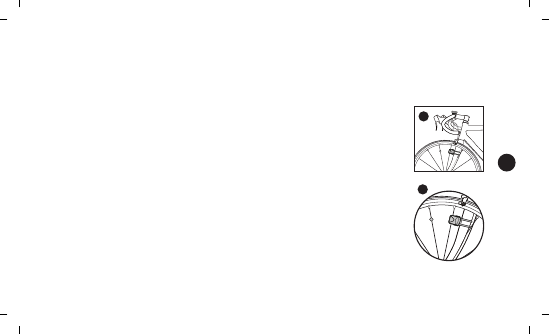Dayton BKSPCD Bike Speed / Cadence Transmitter User Manual
Dayton Industrial Co., Ltd. Bike Speed / Cadence Transmitter
Dayton >
User Manual

16
InstAllIng tHe CyCleComputeR on youR bIKe
InstAllIng tHe wIReless FoRK tRAnsmItteR
Rebel Cyclecomputers receive speed and distance from a wireless transmit-
ter mounted to the front fork.
1. Attach the wireless front wheel sensor and rubber mounting pad to the front
of the left fork blade using the zip-ties provided so the battery cap is pointing
downward. Snug up the zip-ties but do not fully tighten them. The sensor
should be mounted as high on the fork blade as possible. The range of the
transmitter is approximately 18in (46cm). Mounting it high on the fork will
assure good signal reception. Other mounting locations may work, but we
feel this is the best location for most applications.
2. Attach the spoke magnet to a spoke on the same side of the wheel as the sen-
sor. Tighten the attachment screw just enough to hold the magnet in place
but loose enough so that it is still movable.
3. Adjust the position of the sensor and magnet so they are in proper alignment
as shown. The magnet should pass by the sensor adjacent to the molded
plastic line at a distance of 1-3mm.
4. Once everything is in alignment, fully tighten the spoke magnet in place and
tighten the zip-ties holding the sensor to the fork.
2
1
NR_Rebel3-5-8_eng.indd 19 3/5/08 5:24:59 PM

NOTES:
THE MANUFACTURER IS NOT RESPONSIBLE FOR ANY RADIO OR TV INTERFERENCE
CAUSED BY UNAUTHORIZED MODIFICATIONS TO THIS EQUIPMENT. SUCH
MODIFICATIONS COULD VOID THE USER AUTHORITY TO OPERATE THE
EQUIPMENT.
NOTE: This equipment has been tested and found to comply with the limits for a Class B
digital device, pursuant to Part 15 of the FCC Rules. These limits are designed to provide
reasonable protection against harmful interference in a residential installation. This
equipment generates uses and can radiate radio frequency energy and, if not installed and used
in accordance with the instructions, may cause harmful interference to radio communications.
However, there is no guarantee that interference will not occur in a particular installation.
If this equipment does cause harmful interference to radio or television reception, which can be
determined by turning the equipment off and on, the user is encouraged to try to correct the
interference by one or more of the following measures:
-- Reorient or relocate the receiving antenna.
-- Increase the separation between the equipment and receiver.
-- Connect the equipment into an outlet on a circuit different from that to which the receiver is
corrected.
-- Consult the dealer or experienced radio / TV technician for help.
FCC ID: O4GBKSPCD
MADE IN CHINA
This device complies with part 15 of the FCC Rules.
Op e r a t io n is s u b j e ct t o th e fo l l o w i ng c on d i t io n s:
(1) this device may not cause harmful interference, and
(2) this device must accept any interference received,
including interference that may cause undesired
operation.